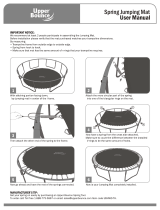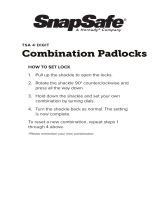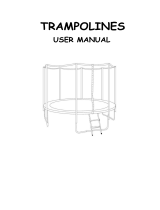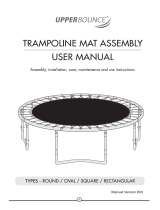Page is loading ...

ASSEMBLY MANUAL

2
MAINTENANCE | CARE INSTRUCTIONS
IMPORTANT NOTES
Metal Rust and Corrosion
• Be aware of areas that are particularly prone to rusting:
- Places where water is easily trapped.
- Hollow sections of steel (which can appear in good condition on the outside, while hiding rust on the inside).
- Sections where different metal components join together.
• Inspect the inside of all frame tubes and poles every 6 months, and remove any water from the inside surfaces.
• Check tube and pole connection areas for rust.
• Use general purpose grease on steel connection areas to reduce the chance of corrosion.
• Avoid excessively cleaning steel components, as it may reduce the effectiveness of our protective coatings.
Textile Deterioration
• Clean your trampoline mat with a soft sponge only to avoid prematurely wearing the textiles.
• Avoid using powerful soaps or detergents; they can damage the textiles.
• Wipe dry any leftover water after rain or cleaning with an absorbent cloth; the mat may discolour or form spots if left to
dry in the sun.
• Remove the textile parts, and store them—in their original packaging—in a cool, dry and dark placewhen the trampoline
will not be used for more than 1 month. Prolonged exposure to UV sunlight can shorten the lifespan of the safety net.
Improper use or lack of care can lead to your trampoline deteriorating earlier than expected. Please follow all of these care instructions to
ensure that your trampoline lasts for as long as possible.
WEATHER CARE
If your trampoline will be unused for any extended period, you should disassemble it and store it out of the weather.
Clean away any fallen debris on your trampoline after rain. Wipe off residual water; any moisture left on the trampolinemay
contribute to the corrosion of steel components and weaken textiles.
Disconnect the safety net from the net poles, and cover the net and mat with a storm cover. Never position your trampoline under
power lines. We recommend that you secure your trampoline with an Anchor Kit.
Disassemble your trampoline.
Assemble your trampoline where it will receive the most shade cover during the brightest times of the day. Cover your trampoline
when not in use to minimise UV damage.
STORAGE
Return your trampoline to its original packaging, and store it in a dry place.
MOVING THE TRAMPOLINE
• Move the trampoline with a minimum of 8 adults, to ensure that the lift is within heavy lifting regulations.
• Do not drag the trampoline; lifting insufficiently may cause the joiners and frame tubes to bend or warp.
• Avoid tilting the trampoline, or resting it on its side; the frame may bend under its own weight.
• Disassemble the trampoline, and return it to its original packaging, to transport it long distances.

3
Use this checklist to inspect the trampoline before each use. Replace any worn, defective, or missing parts to avoid potential hazards. If
the following listed issues are discovered, do not continue to use the trampoline. Contact Vuly or your nearest dealer to order and replace
any parts.
MAINTENANCE | TRAMPOLINE INSPECTION
Frame
Surface of the tubes and poles
Rust Spots
Cracking of the curved areas
Elongation of the net pole holes
Twisted or stretched steel
Sharp protrusions
Damage from the net poles or wire loops
Loose studs
Net Pole Holes
Cracks around the holes
Elongation of the holes
Mat & Safety Net
Mat
Holes
Burn marks
Frayed yarn
Broken sewing threads
Sagging fabric
Faded or torn fabric
Safety Net
Holes
Burn marks
Frayed yarn
Broken sewing threads
Stretched mesh
Torn edges
Stretched seams
Faded materials

4
MAINTENANCE | USAGE
PRECAUTIONARY ADVICE
User: Start by getting comfortable with bouncing by performing small jumps until your confidence and coordination improve. Familiarise yourself with basic
bouncing, landing and stopping movements. This will allow you to develop greater control before you attempt more advanced techniques. Always focus your
eyes on the edge of the trampoline; this will help with basic coordination.
Follow our guide to fundamental skills, and seek professional gymnastic training advice, to further develop your understanding of the dynamics of trampoline
bouncing, and the progression of bounce routines.
Supervisor: Ensure that all safety guidelines are being followed by the user. You must be mature and knowledgeable about trampolines, read this entire
booklet, and ensured that the user has also read this entire booklet.
If no supervisor is available at times when someone may use the trampoline, it should be appropriately disassembled to avoid unsupervised use.
BASIC SKILLS
The following is advice on how to perform the fundamental skills of trampolining:
Bouncing
You should always bounce in the centre of the bed, and only perform controlled bounces in line with your coordination and capability. Always begin your
basic bounces low. Never jump excessively high or recklessly.
The Stop Bounce
This technique will allow you to regain control by quickly stopping your movement. Keep your feet on the mat, and absorb the rebound of the trampoline
through your knees and waist.
This skill should be the first skill that you learn, and you should use it whenever you feel out of balance, or when you land away from the centre of the mat.
To practice the stop bounce:
1. Stand in centre of the mat, with your feet about hip-width apart.
2. Attempt 3 easy bounces; keep them low and controlled.
3. Focus your eyes towards the perimeter of the trampoline to keep your balance.
4. Stop the bounce by bending your knees and hips when you land on the mat.
Arm Actions
Arms are also important for proper lift and control. Whenever you’re in the air, your arms should be too. Raise them as you jump—to about shoulder height
and width. Keep this position until you start falling, then lower your arms to slightly behind the hips. Re-lift them as you bounce again.
Leg Actions
There are three basic leg actions: the tuck, pike, and straddle pike. You should assume these positions at the peak of your bounce, and resume the normal
landing position as you come back down.
Concentrate on getting perfect form as you practice; ensure that your toes are pointed, and your fingers are straight. These simple variations to the basic
bounce are very important for gaining experience in coordinating your movement.
Emergency and Evacuation Procedure
If any part of the trampoline begins to fail, the user should withdraw themselves from the trampoline, and they, the supervisor and any other bystanders
should move away. Disassemble the trampoline as soon as possible to avoid any further use.
Arm Actions
Leg Actions

5
MAINTENANCE | USAGE
HexVex
TM
HexVex™ is a unique, interactive game printed on your jumping mat.
Originally based on ‘Add-ons’, a training tool used by elite trampolinists to improve their co-ordination and reaction time, HexVex™ helps
jumpers to improve their balance and enhance their memory and learn sequence.
Invent new games with HexVex™, and tell Vuly to have them published to the world!
HexVex
TM
Game Icons
A trampoline should be used by one person at a time. Some HexVex™ games are designed to be played by more than one person. Each
player should climb off the trampoline to allow the next player to have their turn.
Players should climb off the trampoline to allow the next player to have their turn.
Match Up
Players: 2
The first player starts in the middle, and beings the game by picking an icon and jump onto it. They then need to jump to the other, matching icon.
That player continues this process, choosing and matching up all nine icons to complete one round. A miss-match jump ends their turn in the game.
The first person to complete three consecutive rounds of matched icons wins.
Mimic Me
Players: 2 or more
The first player starts on the edge of the trampoline, and begins the game by calling out the name of an icon and jumping onto it. Players
then take turns, repeating the icon that the previous player(s) jumped onto, while adding a new icon at the end of the sequence. A player
is out of the game if they jump on an incorrect icon, or execute the sequence in the wrong order.
The winner is the last player left jumping.
Story Hop
Players: 2-3
The first player starts in the middle of the jumping mat, and begins the game by jumping on any icon, and shouting a part of a story that
relates to that icon. That player then continues the story by jumping on the remaining icons to tell a complete story. The other players then
take their turns by doing the same.
The winning player is the one who achieves the most laughs with their story from all the other players.

6
MAINTENANCE | SPECIFIC USE & SAFETY LIMITATIONS
• Ensure that there is adequate lateral clearance. We recommend a minimum of at least 2 m (7 ft) of free space on all sides of the trampoline. This area
should be free of concrete, bitumen, brick or other hard surfaces.
• Keep the area around the trampoline clear, and away from walls, fences, building structures and other play areas.
• Do not place the trampoline on top other objects, or store anything under the trampoline, such as garden tools and bicycles.
• Avoid using the trampoline during gusty or severe winds. Use only when wind or air movement is calm and gentle.
• Place the trampoline in a well-lit area.
SAFETY CHECKS
Perform every checking procedure before using the trampoline:
Product Check
• Inspect the trampoline before and after each use for component deterioration, which can happen over time from use and from environmental and
weather conditions.
- Inspect the safety net structure for missing, improperly positioned, bent, broken or insecurely attached net poles, pole caps and sharp protrusions.
- Inspect the safety net textiles for deteriorated stitching, punctures, fraying, sagging, tears or holes.
- Replace any worn, defective, or missing parts immediately, and through Vuly Trampolines only.
• Check the surface of the mat for foreign objects, and remove them.
• Ensure that the trampoline safety net (and frame padding, if applicable) is correctly fitted.
• Disallow any activity underneath the trampoline.
• Refrain from using the when it is rainy or wet.
• Secure the trampoline properly when not in use to protect against unauthorised use.
• Remove any ladder from the trampoline when not in use to prevent children from falling.
• Lubricate where metal components connect, and on the springs.
• Use only Vuly-made accessories with, or on, our trampolines.
Personal Check
• Avoid bouncing while tired, or bouncing for so long that you become tired.
• Refrain from eating or drinking on the trampoline.
• Avoid bouncing immediately after a meal.
• Do not use a trampoline while under the influence of alcohol or drugs.
• Ensure that the user’s weight is less than 150 kg (330 lbs).
Clothing Check
• Wear clothing that is tight fitting, and that allows you to move freely.
• Wear sun-protective clothing, sunscreen and a soft hat.
• Wear clothing that is free of drawstrings, hooks, loops, buckles, jewellery or anything that could get caught in the trampoline net.
• Do not wear shoes while bouncing, unless they are designed for use on a trampoline and are well-fitted.
Behaviour Check
• Do not allow more than one person onto the trampoline at a time.
• Do not allow any solid or sharp extraneous items onto the trampoline.
• Do not allow pets on the trampoline.
• Do not jump onto or off of the trampoline.
• Do not use trampoline without mature and knowledgeable supervision.
• Do not sit on the edge of the trampoline; additional weight puts pressure on the entire system.
• Do not walk closely in front of, behind or between the trampoline’s moving parts.
• Do not stop any moving parts suddenly while they are in motion.
• Do not use the trampoline in any way that is not described in this manual.
• Ensure that you do not misuse or abuse the trampoline; it could cause serious injuries.
Responsibility rests with the owner and supervisors of the trampoline
to make sure that all users are aware of practices specified in the
Usage and Safety Instructions.
Read all instructions before using your trampoline. For further
information or additional instructional material, contact Vuly or your
nearest trampoline club.
SITE PLANNING
• Place your trampoline on impact-absorbing surfaces, such as
grass, wood chip, non-beach sand (to avoid rusting), rubber or
synthetic compounds.
• Ensure that the site is sufficiently stable to prevent the trampoline
tipping or blowing away. We recommend using the Vuly Anchor
Kit to secure the trampoline to the ground.
• Ensure that there is adequate overhead clearance. We
recommend a minimum clearance of 8 m (26 ft) from ground
level. Provide additional clearance for wires, tree branches and
other possible hazards.
ATTENTION! SAFETY INFORMATION, INSTALLATION, CARE AND MAINTENANCE INSTRUCTIONS.

7
TRAMPOLINE | ASSEMBLY INSTRUCTIONS
FRAME
Take two curved poles, and join them together. If holding up the poles is difficult, join the sections together on the ground.
Continue until you have connected all the curved poles into twos. Arrange the completed pieces on the ground with the joint
connection facing upwards. These will become the frame ring.
Tip: Apply some general purpose grease or vaseline to the inside of the joints. This will help to protect the parts from creaking
as the frame ages..
1
STEP
Time required: Approximately 1 hour - Number of people required: 2
Quantities:
Parts 8 ft 10 ft 12 ft 14 ft
Safety Padding
1 1 1 1
Jumping Mat
1 1 1 1
Curved Poles
6 8 8 8
Straight Poles
6 8 8 8
W-shaped poles
3 4 4 4
Springs
60 64 72 88
Spring Tool
1 1 1 1
Spring Buttons in W-Shaped and Straight Poles
12 16 16 16
Net
1 1 1 1
*Lower Net Pole
6 8 8 8
*Upper Net Pole
6 8 8 8
*Net Pole Covers
18 24 24 24
*Net Pole Foams
18 24 24 24
*Elastic Ties
18 24 24 24
*Nuts
18 24 24 24
Spring Buttons
12 16 16 16
*Parts pre-assembled

8
TRAMPOLINE | ASSEMBLY INSTRUCTIONS
Take one W-shaped pole, press the spring button and insert a straight pole into each end. Twist the straight poles until the
spring button clicks again—locking the poles together. Continue until you have connected all straight and W-shaped poles.
Arrange the completed pieces on the ground. These will become the legs.
2
STEP
Take one completed W-shaped section (leg), and insert the straight poles into the connections on the curved poles (frame).
Continue until you have all the legs attached to the frame.
Note: Make sure that all spring locks engage—the buttons on the straight poles must be on the same side as the connection
holes on the curved frame.
3
STEP

9
TRAMPOLINE | ASSEMBLY INSTRUCTIONS
Hook the springs into the frame’s holes.
5
STEP
Lift two of the combined frame and leg sections, and flip them so that the legs are resting on the ground. Holding each
section of the curved frame with one hand, join and tighten the two together very securely. Continue to join the curved frame
sections together until you have completed the frame ring.
4
STEP
TRAMPOLINE | ASSEMBLY INSTRUCTIONS

10
Lay out the jump mat in the middle of the frame. Hook a
spring to the most centre hole between every two T-joints,
and then onto one of the ‘D’ shackles on the jump mat.
• 10 ‘D’ shackles for 8ft,
• 8 ‘D’ shackles for 10ft,
• 9 ‘D’ shackles for 12ft,
• 11 ‘D’ shackles for 14ft.
Repeat until one spring is attached to each curved section
of the frame ring.
6
STEP
Lay the net onto the trampoline, and find the seam to the
left of the zipper doorway. Align the hole on the left of the
seam’s base with the first spring slot on the left of the joint.
Push the hole in the net at the bottom of the seam over the
‘D’ shackle on the mat. Attach the spring.
7
STEP
TRAMPOLINE NET
Work your way clockwise around the trampoline,
pushing the holes in the net at the bottom of the seam
over the ‘D’ shackles on the mat.
8
STEP
TRAMPOLINE | ASSEMBLY INSTRUCTIONS

11
Remove one of the hanging springs from the frame, and hook it to the jump mat’s ‘D’ shackles.
Use the spring tool to hook it back onto the frame.
9
STEP
Continue attaching the springs equally around the
entire frame. Ensure that there is even spring pressure
as you attach.
10
STEP
Use the spring tool to remove the springs that you
initially attached to the frame before you laid the net
onto the trampoline. Re-attach these springs with the
net holes pushed over the buckles, as outlined in Step 7.
11
STEP
TRAMPOLINE | ASSEMBLY INSTRUCTIONS

12
Place the pads on the frame of the trampoline. Ensure that the logo on the pad aligns with the entrance of the door, and that
the holes in the pads align with the holes in the frame joints.
12
STEP
Attach the upper net pole (with black plastic cap) to the
lower pole. Repeat for all the net poles.
14
STEP
Find the closest spring to a safety padding loop, and
using your spring tool, remove that spring from the
frame. Feed the spring through the safety padding loop,
and reattach the spring to the frame.
Repeat for each loop on the safety padding until it is secure.
Tip: If you have purchased a skirt, and want to install
it, do so now. Follow your Skirt instructions.
13
STEP
Place your assembled poles in the holes at the ‘T’
intersection, lining the spring button up with the hole
in the ‘T’ intersection. The net poles should now be
secured in the frame.
15
STEP
TRAMPOLINE | ASSEMBLY INSTRUCTIONS

13
TRAMPOLINE | ASSEMBLY INSTRUCTIONS
Work your way around the trampoline, attaching the net buckles to the elastics on the net poles.
16
STEP

CONGRATULATIONS!
You have finished assembling your Vuly Classic Trampoline.


vulytrampolines.com
/








